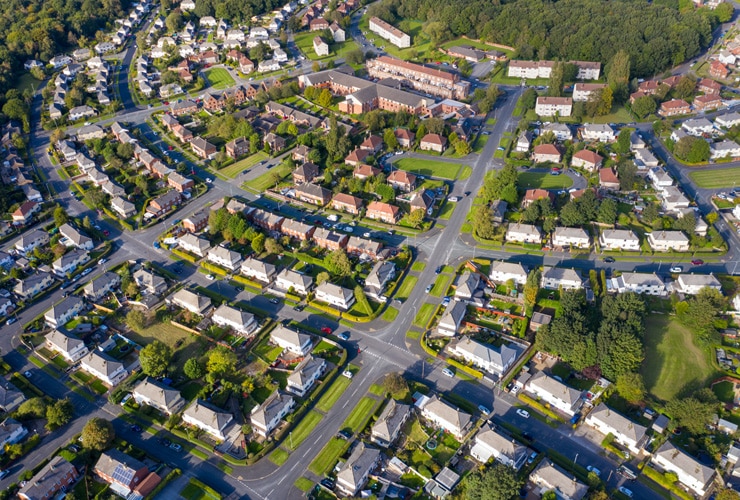What is a UPRN? Unique Property Reference Number Explained
There's plenty of data available on property areas, like average asking prices, rental yields, growth trends by postcode. But when you're doing due diligence on a specific property, area data only gets you so far. You need information about that building, that flat, that exact address.
That's where UPRNs (Unique Property Reference Numbers) become useful.
Article updated: November 2025
Contents

-
by Robert Jones, Founder of Property Investments UK
With two decades in UK property, Rob has been investing in buy-to-let since 2005, and uses property data to develop tools for property market analysis.
What is a UPRN?
A UPRN (Unique Property Reference Number) is a 12-digit number assigned to every addressable location in Great Britain. Every house, flat, commercial unit, even things like electricity substations and bus shelters gets its own UPRN. Unlike postcodes, which cover whole streets or blocks, a UPRN points to one specific property and one only.
Here's what one looks like: 10023456789
The number never changes. It stays with that property from the day it's built until the day it's demolished. And because it's a standard identifier used across government systems, utilities, and increasingly the property industry, it gives you a reliable way to pull together data from different sources and know you're definitely looking at the same building.
This matters more than you might think. Take a freehold building that's been split into leasehold flats, maybe with separate parking spaces too. That's potentially multiple Land Registry titles, multiple council tax records, multiple EPC certificates. All for what looks like "one property" from the outside. Having the correct UPRN for each element helps you avoid pulling data for the wrong unit or missing something entirely.
How to Find a Property's UPRN
The quickest way is through FindMyAddress at findmyaddress.co.uk. Enter the postcode, and you'll see every property listed with its UPRN alongside. Click through and it shows you exactly where the property sits on a map. Takes about 10 seconds.
You get 30 free searches a day for personal use, plenty for checking individual properties during due diligence. If you need bulk lookups or want to use UPRN data commercially, you'd need to go through Ordnance Survey's AddressBase products, which come with licensing costs.
Some council websites also let you look up UPRNs, particularly when you're digging into planning applications or licensing records.

Where Do UPRNs Come From?
Ordnance Survey developed the system over 20 years ago. Today it's managed by GeoPlace, which coordinates data from Ordnance Survey and all 348 local authorities in England and Wales.
When a new property is built, the local authority assigns its UPRN. When a house gets converted into flats, new UPRNs are created for each unit. The system updates continuously as properties are built, demolished, subdivided, or merged.
Originally only organisations with specific licences could access this data. Now it's available to anyone under the Open Government Licence, which is why free lookup tools exist.

UPRN vs USRN - What's the Difference?
A UPRN identifies a property. A USRN (Unique Street Reference Number) identifies a street.
USRNs were created so utility companies could coordinate roadworks. When multiple firms want to dig up the same road, everyone needs to be clear about exactly which stretch they're talking about. The two systems link together: a property's UPRN connects to the USRN of the street it sits on.
For property investment work, you'll mostly deal with UPRNs. USRNs become more relevant if you're involved in development or infrastructure.
UPRN vs UDPRN - Don't Get Them Confused
This catches people out.
A UDPRN (Unique Delivery Point Reference Number) is a separate system run by Royal Mail. It identifies addresses on their delivery database, but only covers places where Royal Mail actually delivers. UPRNs cover every addressable location whether it receives post or not.
A property will often have both identifiers, but they'll be different numbers from different organisations. For property research, the UPRN is generally what you want. It's the standard used across government and the property industry.
When UPRNs Are Actually Useful
I'll be honest, UPRNs aren't something I think about day-to-day. They become useful in specific situations, mainly during due diligence before a purchase.
When you're researching a property, there's a lot of data to pull together: sold price history, planning applications, EPC ratings, flood risk, selective licensing status, Land Registry records. The challenge is making sure all that information relates to the exact property you're looking at, not the flat next door or a different unit in the same building.
Area-level data is easy to find. Rental yields by postcode, average prices for an area, growth trends, that's all readily available. But property-specific data requires more care. Using the UPRN helps you track down information that's tied to that exact address, which reduces the risk of missing something or working from the wrong data.
It's not essential for every purchase. But for anything complicated, conversions, HMO properties, buildings with multiple units, having the correct UPRN for each element helps you keep things straight.
How UPRNs Are Used More Broadly
Government and local authorities use UPRNs as standard across most property-related systems. Council tax, planning applications, building control, licensing, it's all indexed by UPRN.
Utility companies use them too. When you set up broadband or report a gas issue, providers can use the UPRN to pull the full history of that property's connections.
Property portals are gradually adopting the system. Zoopla already uses UPRNs to identify listings. As more of the industry follows, comparing data across sources should get easier.
In conveyancing, there's potential for UPRNs to reduce errors and speed things up. Instead of matching addresses that might be written differently on different documents, solicitors could use the UPRN to confirm everyone's talking about the same property.
Limitations Worth Knowing
UPRNs only cover Great Britain. Northern Ireland uses a different system called Pointer.
New developments can take a while to appear. There's sometimes a lag between completion and the UPRN showing up in public tools, so very recent builds might not be findable yet.
When properties get subdivided or merged, the history gets messy. Convert a house into three flats and you get three new UPRNs, but historical data from the original house UPRN doesn't transfer automatically.
Commercial use requires licensing from Ordnance Survey. The free lookup tools are for personal use only.
Frequently Asked Questions
What does UPRN stand for?
UPRN stands for Unique Property Reference Number, a 12-digit code assigned to every addressable location in Great Britain. Every house, flat, commercial unit, and even objects like electricity substations and bus shelters has its own UPRN. Unlike postcodes which cover whole streets or blocks, a UPRN identifies one specific property and one only.
How do I find my property's UPRN?
The quickest way is through FindMyAddress. Enter the postcode or address, and every property in that location appears with its UPRN. Click through and it shows you exactly where the property sits on a map. You get 30 free searches per day for personal use, which is plenty for checking individual properties during due diligence.
Is a UPRN the same as a title number?
No. A UPRN identifies a physical location and is managed by GeoPlace and Ordnance Survey. A title number identifies registered ownership and is managed by Land Registry. The same property will have both, but they're separate systems serving different purposes. The UPRN stays the same regardless of who owns the property, while the title number relates to the legal ownership record.
Do all properties have a UPRN?
All addressable locations in Great Britain should have one, including residential properties, commercial buildings, and even objects like bus shelters. Northern Ireland uses a different system called Pointer. Very new properties may have a delay before appearing in public databases, as there's sometimes a lag between completion and the UPRN showing up in lookup tools.
What's the difference between UPRN and UDPRN?
UPRN covers every addressable location in Great Britain and is managed by local authorities through GeoPlace. UDPRN (Unique Delivery Point Reference Number) is Royal Mail's system and only covers addresses that receive postal delivery. A property will often have both identifiers, but they'll be different numbers from different organisations. For property research, the UPRN is generally what you want as it's the standard used across government and the property industry.
Can I use UPRNs commercially?
Free tools like FindMyAddress are for personal use only. If you need bulk lookups or want to use UPRN data commercially, you'll need licensing from Ordnance Survey through their AddressBase products, which come with associated costs. For individual property checks during due diligence, the free personal use allowance is usually sufficient.
